WordPress is a powerful tool that helps bloggers and business owners spread their message through its sophisticated CMS. Likewise, Google Docs is an efficient tool for content production and collaboration.
However, content creation can become frustrating when you’re constantly running into issues while copying from Google Docs to WordPress.
Messy code, formatting issues, and image problems create bottlenecks in the production line and slow down content distribution.
Here are 6 simple tricks that solve these Google Docs to WordPress issues, making it easier for you to work between them.
Prefer to watch the video version?
The Issue With Copying From Google Docs to WordPress
Many bloggers, business owners, and content marketing teams use Google Docs to create content because it’s free, simple, and collaboration-friendly. Google Docs is also a part of Google’s Google Workspace, a range of SaaS tools that we use here at Kinsta.
However, when it comes to transferring content from those Google Docs to WordPress, you may find you run into some hurdles.
Let’s take a closer look.
Imagine you’re trying to copy the following Google Doc to WordPress:

You select the text and then head over to your WordPress editor and paste it.
Here’s where problems arise, mainly if you’re still using the Classic Editor in WordPress. You’re likely to experience all kinds of formatting issues if you try to copy and paste directly from Google Docs to your WordPress post.
Spacing is the most prominent issue. When you copy your Google Doc across, WordPress tends to add in extra line breaks:

The solution is more complex than just removing these spaces, though.
When you switch from the visual editor to the code editor, you’ll see that the code is messy:

There’s lots of unnecessary code, including extra line breaks:
(or sometimes <br /> )There are also additional span styles everywhere:
<span style="font-weight: 400;"> </span>When you copy lists into your blog post, you’ll also notice different font weights, often using this code:
<li style="font-weight: 400;" aria-level="1">You need to remove all this surplus code, as it can affect your website performance. HTML counts toward your overall page weight, so unnecessary code slows your page down (which is an even more significant factor with Google’s Page Experience algorithm update).
It means a lot of backspacing, which can take serious time.
Another significant issue is that images don’t carry across.
Ideally, you want to upload images separately anyway, as you’ll need to compress them and add a relevant name for SEO purposes.
However, if you wanted to copy and paste images across quickly, you couldn’t.
So what can you do about it? Try following these handy tricks below.
How to Import from Google Docs to WordPress
Here are some easy ways to streamline the process of uploading Google Docs to WordPress:
1. Switch to the Gutenberg Block Editor
The Gutenberg block editor was released with WordPress 5.0. If you’ve already switched to Gutenberg, you’ll have noticed that many of the problems typical with the Classic Editor don’t exist anymore.
When you copy the text across, you don’t get the same formatting issues (such as extra spacing).

If you flip from the WordPress visual editor to the code editor, you’ll also see that there’s no unnecessary code added.

If you wanted to stick with the Classic Editor, you’ve likely chosen to disable the Gutenberg editor.
However, WordPress will only support the Classic Editor until the end of 2021. If you’re experiencing annoying formatting issues, it makes sense to switch now instead of waiting until you have no choice.
All this aside, the Gutenberg Editor does have some of its problems related to images and time spent inserting metadata.
While you can copy images across, when you head to the code editor to see the code associated with your copied images, it will look something like this:

As you can see, the code after “<img src=” points to the location of your image file.
When you copy your images straight from Google Docs, you’re hosting your website images through your personal Google Docs account.
It’s not usually preferable to link your website directly to your Google Account without also beefing up your security measures. Plus, if you delete the original file or the Google Doc containing the image, it will disappear from your website, too.
It means you need to go through and remove all images you’ve copied across and add them to the WordPress media library manually.
The other major bottleneck is metadata.
Just like with the Classic Editor, you’ll have to manually add your permalinks, alt tags, meta descriptions, excerpts, and all that good stuff that optimizes an article for search.

This optimization process is lengthy and adds to production time.
2. Try Wordable to Streamline the Google Docs to WordPress Workflow
One option that significantly reduces the uploading time is Wordable.
Recognizing that it takes around half an hour to upload, format, and optimize content manually, Wordable created an all-in-one solution to accelerate this workflow.
With Wordable, it’s a one-click process to import your Google Doc and create a new WordPress blog post.
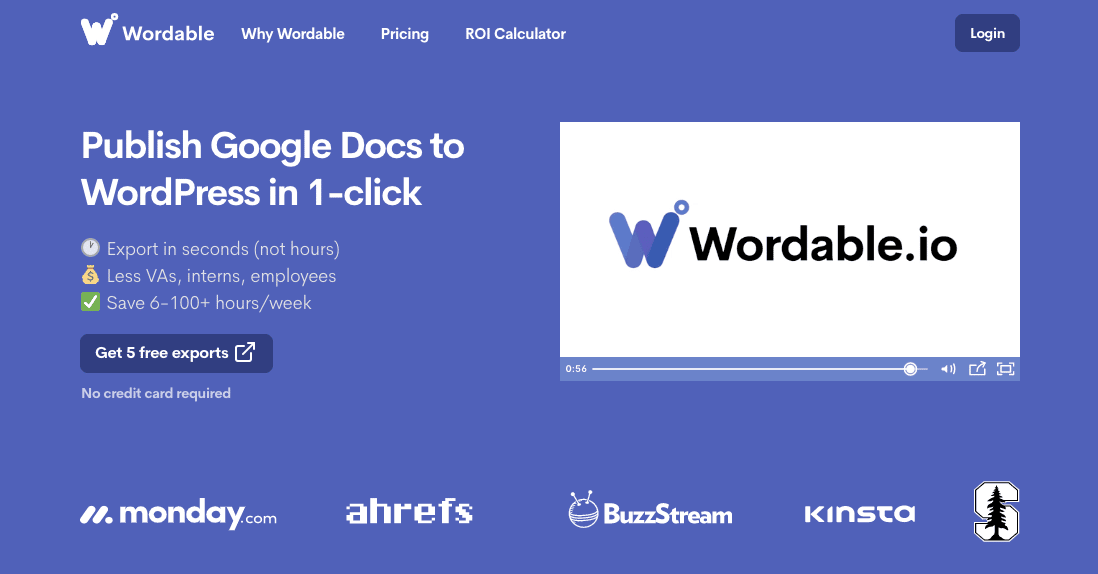
Wordable makes it incredibly simple to export Google Docs straight to WordPress, individually or in bulk, and either publish posts automatically or save them as drafts.
Wordable will automatically clean up all the messy HTML while retaining your tags, headers, bolding, italicization, bullets, and images.
Copying text from Google Docs to WordPress isn’t the only thing that Wordable does. Wordable can also help you optimize your content and boost search engine optimization (SEO) with one-click transformations.

For starters, Wordable can help to boost page speed by compressing images and resizing them, automatically, based on your document settings — while still retaining image quality.
Improving page speed is the number one SEO tactic used by marketers, and compressing images helps web pages run faster.
Wordable will also automatically add your alternative text (alt text) for your images. The alt text describes a picture, giving people a better idea of what an image conveys. As it turns out, this description exists within the page’s code and therefore helps search engines get a better feel for what the page is.
By optimizing your alt-text for target keywords, you improve your SEO. However, this can be time-consuming. Either you’re manually writing all the alt text in WordPress yourself, or you’re copying and pasting writer suggestions from comment cards in Google Docs.
Wordable makes this process far easier with the click of a button.
You also won’t have to manually upload a featured image to every single article after it’s exported with their “select featured image” feature.
You can set all the meta information with one click, too. Wordable will add the author, select the right category, add your meta descriptions and title tags, set permalinks, and more.
Another way that Wordable speeds up post-production is with the one-click transformation that sets all links to open in a new tab. If you leave your links as they are, readers navigate away from your page when they click on a link.
However, manually switching all links to open in a new tab takes ages. With Wordable, it takes one click and a few seconds.
Speaking of speeding up your exports, templates allow you to save all of the manual settings you want to apply to each export, details like the website(s) you’re exporting to; the transformations or automations to apply to each export; the author, category, and even post type or page. You can also customize any mix of these so that your recurring preferences are loaded & applied consistently with just a single click.
Another bonus of Wordable is that you can also integrate it with HubSpot, Medium, and WordPress.
Now, if you’re concerned about security and privacy, and ONLY want specific folders within your Google Drive to be visible, you can select the “limit visibility to added sources” option.
Selecting this means that only the connection owner is able to see and search these documents. No one else (like team members you might add) will be able to view these options.

They have a free trial, which allows you to give it a try. It comes with five free exports for one WordPress site.
If you need more exports and the ability to export to multiple WordPress sites, the premium version starts at $49/month for solo users.
While this does sound costly, if you use Google Docs every day, this service pays for itself.
Follow the steps below to export from Google Docs to WordPress easily.
Step 1
Sign up at Wordable for a free account.
Step 2
Add your Google Drive by simply clicking on the giant Google Drive button during onboarding, or on the Drive icon on the Connections page, to add a new Google account. Then, Google will ask your permission to allow Wordable to properly access your files.
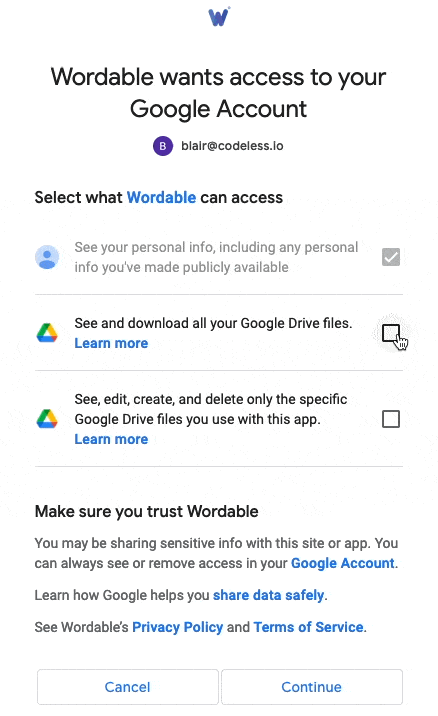
Step 3
Connect your WordPress site by downloading and installing the plugin (either from the WordPress plugin repository or by downloading it with this link). Then, activate the plugin. Finally, go into Wordable -> Settings and click the Connect button to see the green successful notification.
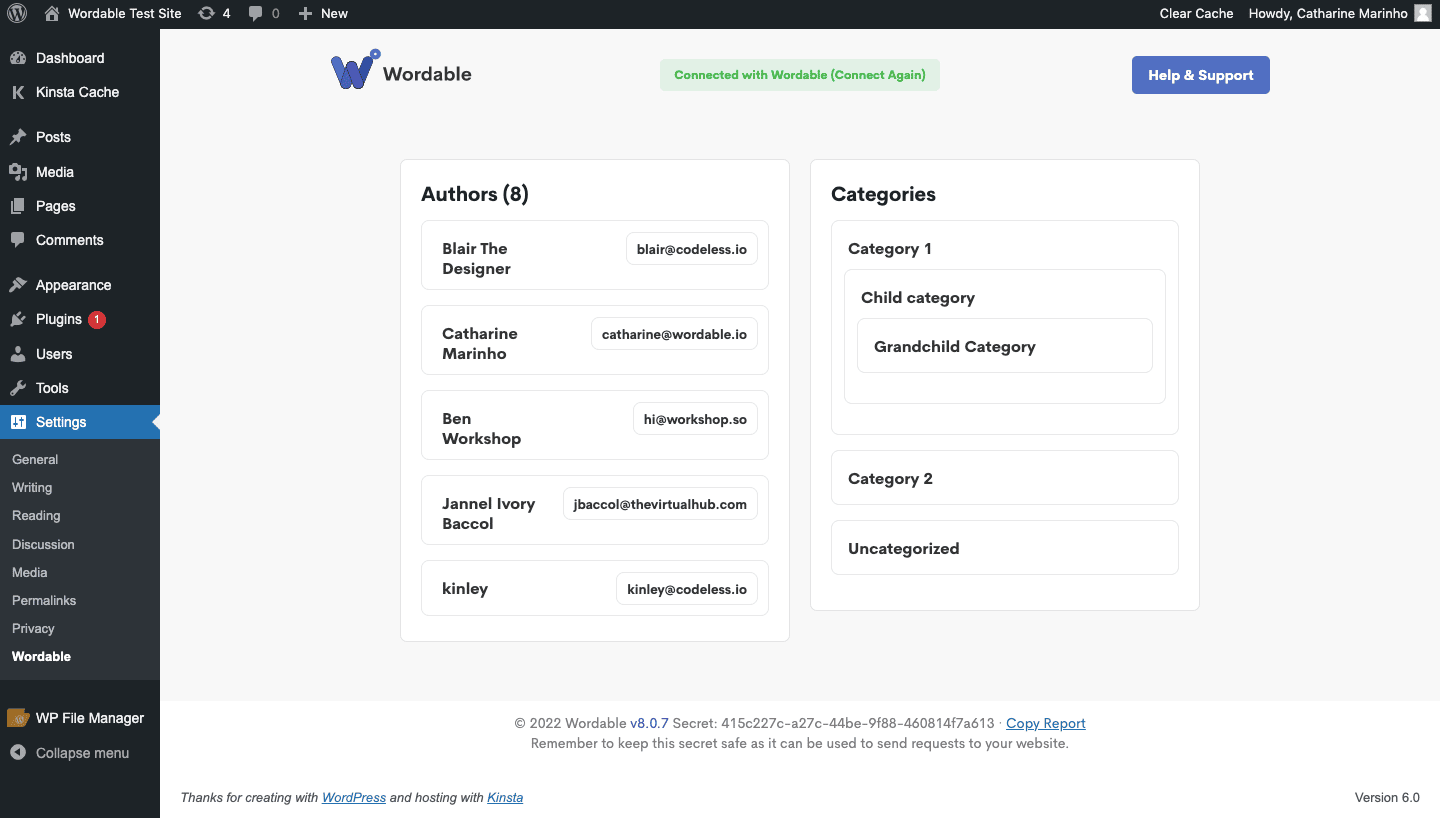
Step 4
Search for the document in your Google Drive list and import it to Wordable:
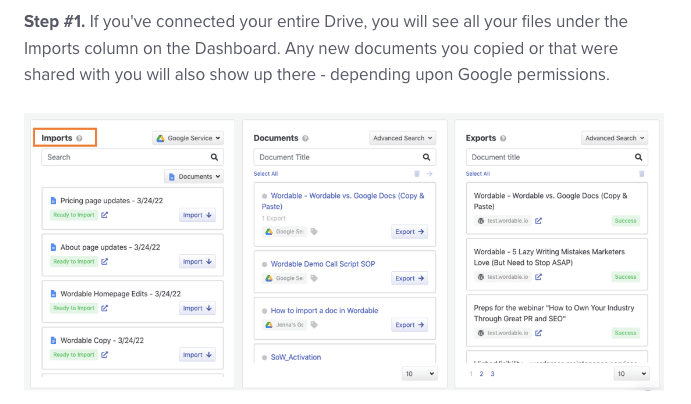
Step 5
Click on either Manual Export or One-Click Export to create a draft of your blog post on your WordPress site:

Step 6
Click on the external link icon to visit your WordPress admin dashboard to check your draft and publish the post.
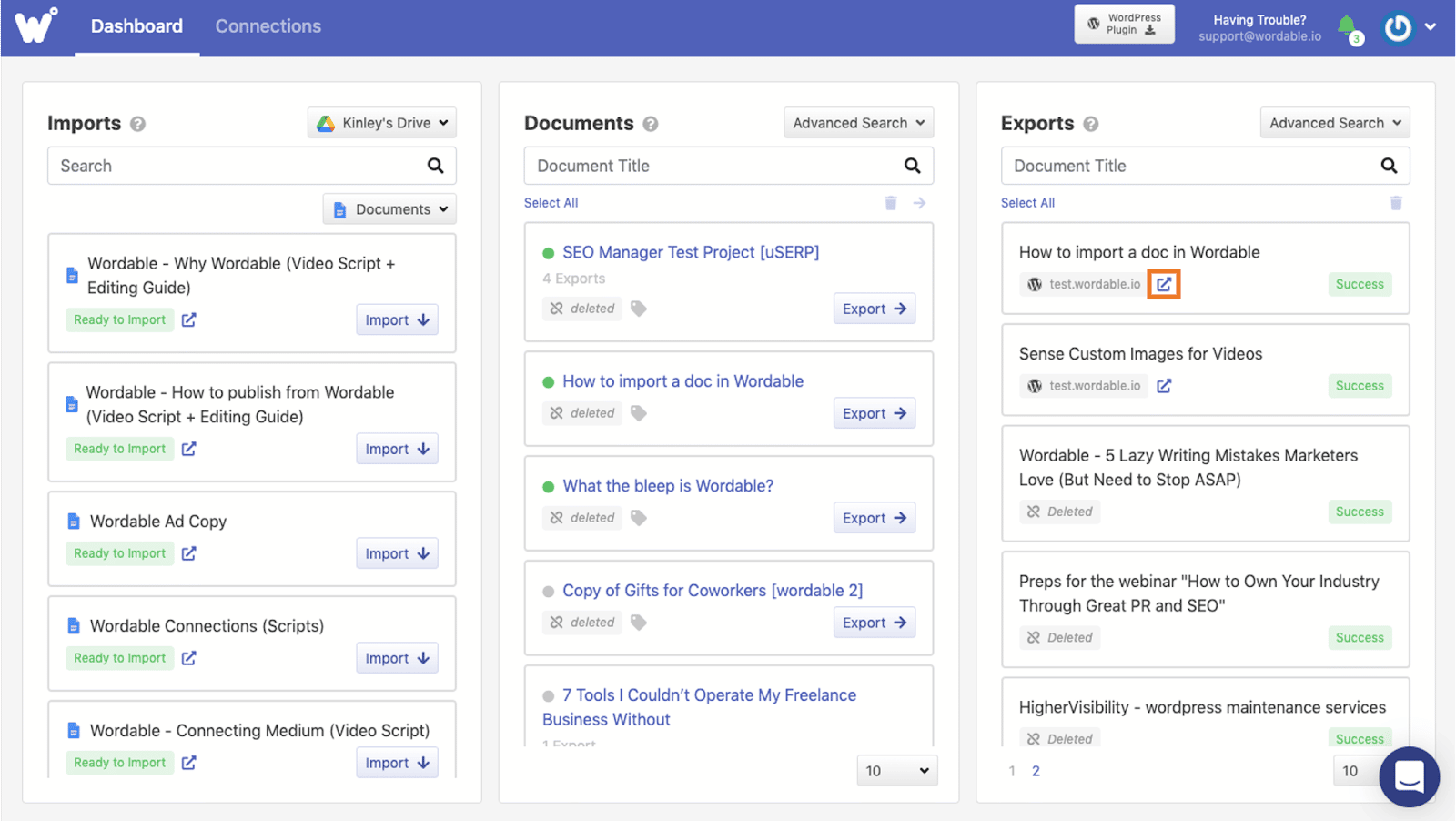
Here’s how our draft looks in the WordPress editor after having been imported:

All the formatting moves across perfectly without inserting extra code. Images will also transfer over and automatically upload to your WordPress media library. Remember to name all images with SEO-friendly filenames. Wordable will export images with this filename to help boost SEO.
If you don’t do this initially, you’ll have to go through and manually change the filenames in the media library afterward.
If you’re looking for a super-efficient option to upload Google Docs content straight to WordPress, Wordable is ideal. Not only do the text and images copy across perfectly, but it’s also faster to make sure all metadata is in place.
3. Install the Mammoth .docx Converter Plugin
You can also use a WordPress plugin, like Mammoth .docx converter, which converts .docx documents to HTML.
This plugin is super popular, with over 30,000 active installs and a 4.8-star rating out of 5. It also has basic support for the Gutenberg block editor, which is especially useful if you’re making the switch to the new editor.
To use the Mammoth .docx converter, you’ll need to download your Google Doc as a Word document and then run it through the plugin.
Here’s how you do this:
Step 1
Download, install, and activate the free Mammoth .docx converter plugin.
Step 2
Next, you’ll download your Google Doc as a Microsoft Word .docx document. Head to the File menu in Google Docs, choose Download, and select Microsoft Word (.docx).

Step 3
Then, head to WordPress and create a new blog post. Scroll to the bottom of the editor, and you’ll see a new box for the Mammoth .docx converter:

Select Choose File and pick the .docx you just downloaded.
Make sure to select the Visual option, not Raw HTML or Messages.

Then, click Insert into Editor.
It’s an excellent tool if you’re looking to transfer large amounts of text.
The plugin will copy the formatting across correctly, including each header tag, bold formatting, lists, and images. Images will also transfer with their original filename, so make sure you’ve named images for SEO purposes.
There is one thing to watch out for, and that’s odd anchor text in the header tags. It might look like this:
<h2><a id="post-264-_1e9slkz7q807"></a>First Header</h2>To get rid of these anchor tags in one go, copy the “text” version in the code editor. Head to a text editor, such as Sublime, and paste your “text” version.
Hit Command + Option + F to use the Find and Replace tool.
Click on .* to enable regular expressions and enter the following expression into the Find field:
(<a id="post-).*</a>
It’ll highlight all the rogue anchor tags.
Leave the Replace box blank and click Replace All. It’ll remove these anchor tags across your entire document.
Now copy the text version and paste it back into the code editor.
4. Use the Jetpack WordPress.com for Google Docs Add-On
You can also try Jetpack with its free add-on for Google Docs. It’s very straightforward to install and use, and the tool allows you to post directly from Google Docs.
Step 1
First, you need to download the Jetpack plugin from the WordPress repository. You can also search for it in the Plugins section of your WordPress admin dashboard.
Step 2
Next, install the free WordPress.com to Google Docs add-on from Google Workspace Marketplace. You can also find the Google Workspace Marketplace by heading to the Add-ons menu in Google Docs and clicking on Get add-ons.

Step 3
Click Install to add this tool to your Add-ons menu. You’ll need to permit to access your Google Docs.

Step 4
Once installed, click Add-ons in the top menu and select WordPress.com to Google Docs. Then click Open.

A window will appear on the right-hand side of the screen. Click Add WordPress Site to connect to your WordPress blog:

Step 5
When you’re ready to post to your website, select the categories and add tags. Then, click Save to publish your article as a draft:

Here’s how it looks in the WordPress editor:

Notice how all the formatting transfers perfectly. Images also come across with their original filenames, although you should add these separately so that you can compress them using a third-party tool.
5. Convert to Markdown with the Docs to Markdown Add-On
One way to get over the formatting hurdle is to convert your text to Markdown. Markdown is a lightweight markup language that creates formatted text through a plain-text editor.
The Docs to Markdown add-on is a top tool for this, especially if you’re working with large documents.
The tool will convert your fully formatted Google Doc to Markdown format (.md) with a few quick clicks. You can copy this Markdown text into the text editor on WordPress for perfectly formatted text.
Before using this tool, you must enable Markdown in your WordPress settings.
Head to Settings and click on Writing. Next, check the box next to Use Markdown for posts and pages.
Now you’re ready to convert your Google Doc to Markdown.
Step 1
Install the Docs to Markdown add-on from the Google Workspace Marketplace or through Get add-ons in Google Docs:

Step 2
Once installed, head to the Add-ons menu in Google Docs and open the tool by clicking Convert.
Step 3
Highlight the text you want to convert to Markdown, and then click Markdown in the box on the right:

Copy the Markdown text from the box on the right.
Step 4
Now, head over to your WordPress site and add a new post. Switch to the text editor and paste your Markdown text.
Be aware that this isn’t a tool for transferring images across to WordPress. Use this exclusively for text.
6. Give Writers a WordPress Account
If none of these options work for you, you can create separate WordPress accounts for each writer and require that blogs be written directly in the editor.
While this saves on formatting issues, you will need to manage multiple accounts and possible security impacts.
While WordPress offers six different user roles, it’s best to stick with these two for writers:
- Author: Can publish and manage their posts.
- Contributor: Can write and manage their posts, but cannot publish them.
To create an account for a writer, head to Users in your WordPress dashboard and click Add New.
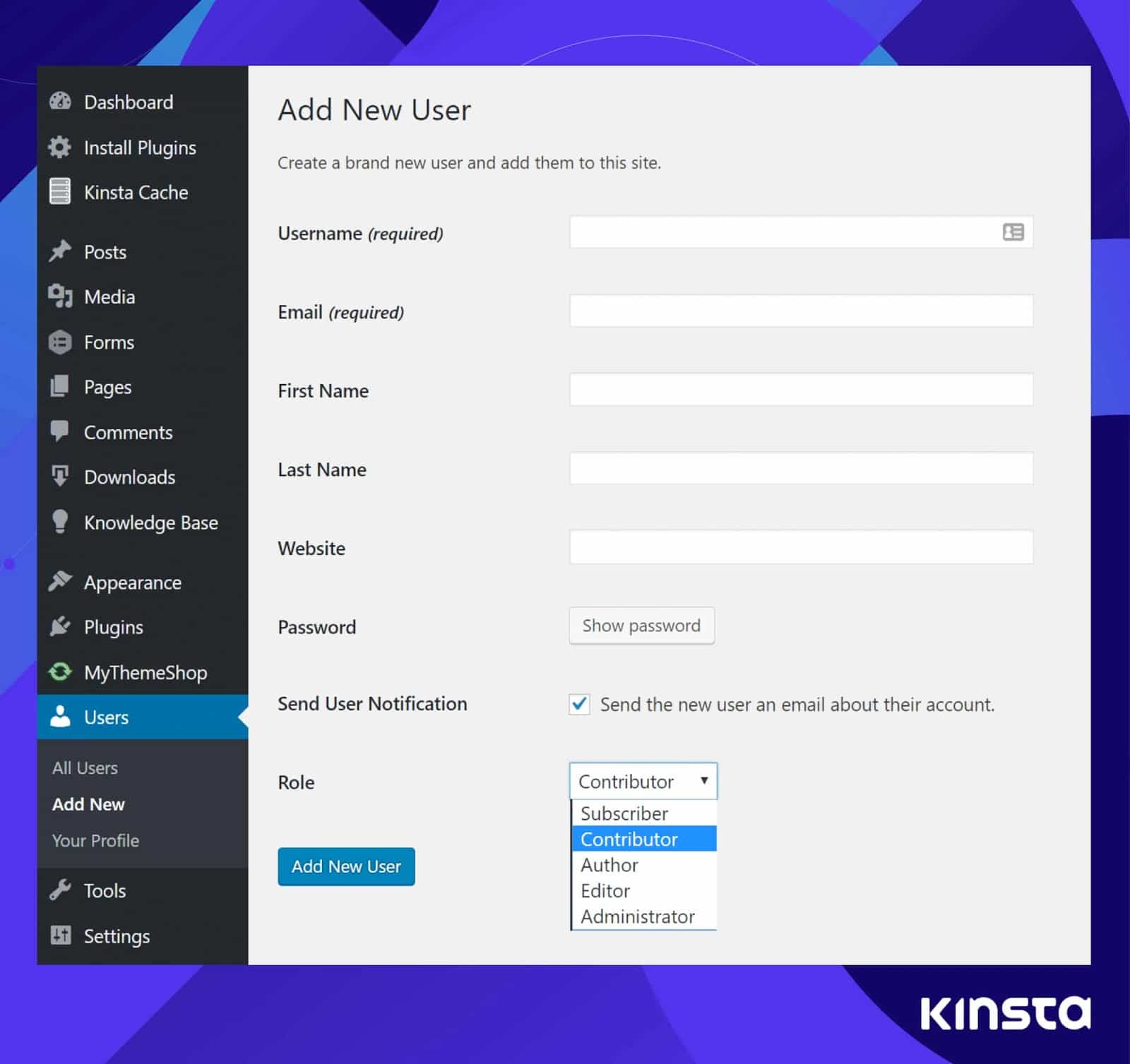
Fill in the details and select the appropriate role from the dropdown menu.
7. Use Multicollab — a Google Docs Style Collaboration Plugin for WordPress
Multicollab provides your favorite collaborative features of Google Docs, like inline commenting, suggestions, @mentions, email notifications, and more in WordPress. The Multicollab cuts all the time and trips to copy and paste the content between Google Docs and WordPress, which makes publishing 42% faster. For that reason, the Multicollab plugin is a perfect alternative to Google Docs for publishing content in WordPress.

Installing Multicollab enables the following key editorial features instantly:
- Inline Commenting – add a comment directly to all content in posts and pages with a single click.
- Tag and mention multiple colleagues – just pick the persons you need to highlight your feedback to directly within your comment.
- Assign comments directly – tag a colleague who needs to take action and let them know clearly what the task request is
- Reply and Resolve – get back to your colleagues on previous comments, and close off comment threads that have been fully resolved with one click.
- Suggest Edits – Using the suggestion mode feature, you can turn any edits to the post into a suggestion. This feature is great for proofreading and developmental revisions.
- Advanced Reporting – As you do content drafting, editing, and collaborating all in WordPress, you get insightful reporting and collaboration activities better than Google Docs.
View the demonstration video for more details.
8. Use Docswrite
Docswrite is a tool that helps to export Google Docs to WordPress. Saves many hours of manual copy-pasting and fighting with formatting. They can even integrate Docswrite into their existing content workflow and can export from their existing tool, like Trello.
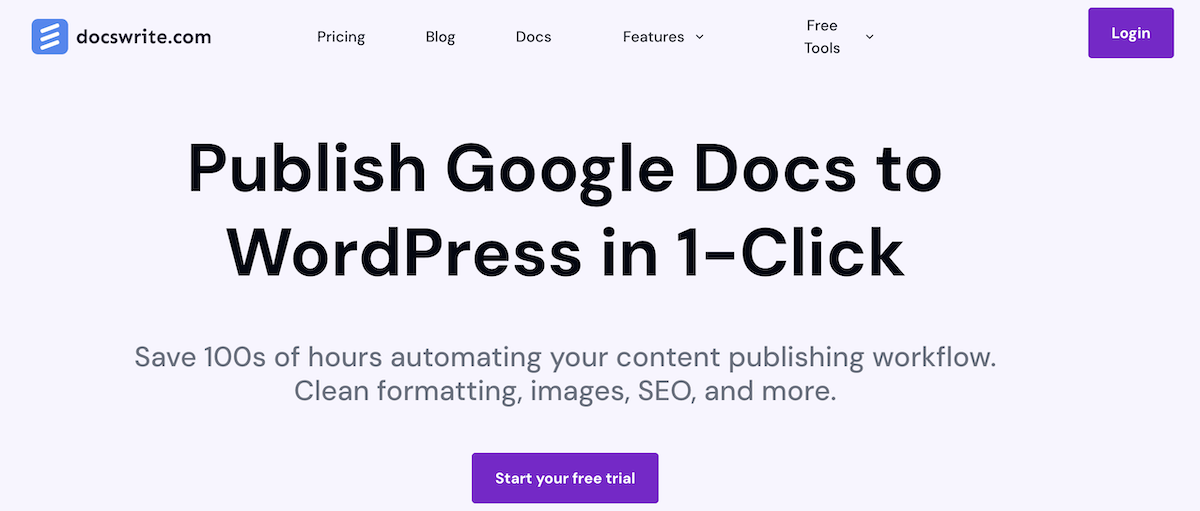
You can visit the Docswrite Help Center to easily get started. They even have a full video walkthrough if you prefer.
Summary
If you or your team regularly adds blog posts to your website, it’s time to consider a more streamlined approach to uploading content from Google Docs to WordPress.
If you haven’t yet moved to the new Gutenberg block editor, it may be time to make a move before you dive into the deep end at the end of 2021.
Have more thoughts on these solutions? Any further formatting issues you can’t solve? Let us know your feedback.


